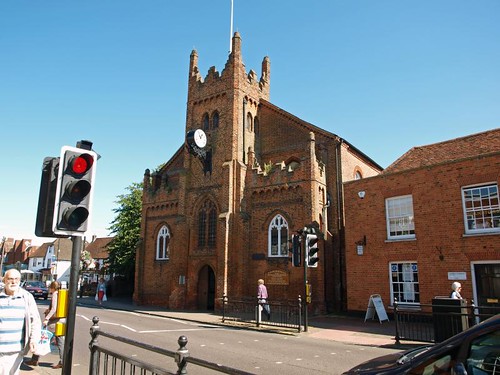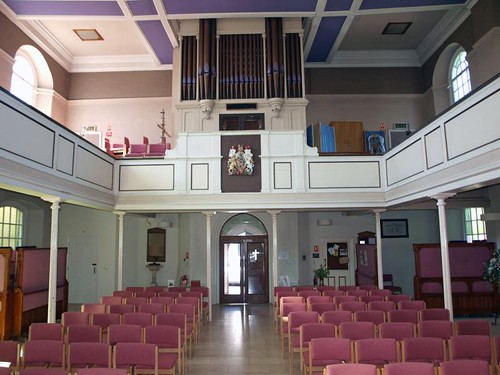ST MARY MAGDALENE. Brick W tower of c. 1500, with set-back buttresses below and chamfered angles above continued in polygonal pinnacles. The battlements between these are stepped (cf. East Horndon). The battlements rest on a trefoil-arched corbel frieze. W window of two lights with Perp brick tracery. The W ends of the aisles in the same style, probably 1880. The interior late C18 with a shallow apse at the E end and another facing the triangle of High Street and Chapel Street to the N. Three galleries on thin cast-iron columns. - FONT. Bowl with two cherubs’ heads, C18. - COMMUNION RAIL. C18.
BILLERICAY. It has quaint old buildings and tragic memories;the thread of English history runs through it. In a neighbouring wood the followers of Jack Straw were caught and massacred on their way home in the great Peasants Rebellion, a tragic chapter for a village; but it is the human tragedy of a little group of people who died for their faith that is so poignant here.
To walk down the High Street is like walking through 400 years. The village grew up round a chapel attached to Great Burstead, but it has left Great Burstead far behind, though its old folk are still buried with their ancestors in the shadow of that splendid church. Billericay’s church is 18th century, with galleries all round, but it has a medieval brick tower with a crow-stepped parapet and pinnacles, and its bell has been ringing 600 years. Behind the church is a row of 16th and 17th century cottages, and in front of it is the Chantry House with timbers that must have been growing when the Conqueror came, for the house was built in 1510. One of the cottages has a medieval barn built with upright logs. In Chapel Street is a chapel founded in 1672, and its graveyard faces Mayflower Hall, which has a tablet commemorating a gallant company of village heroes, Christopher Martin and his wife Marie, her brother-in-law Solomon Prower, and their servant John Langerman. They sailed in the Mayflower on the most historic voyage of the modern world. There is still here for us to see something of the mill in which they ground the flour for provisioning this famous ship.
Christopher Martin was a boy on these hills in the days of Queen Elizabeth, when men were free to believe in God and worship Him in any way they pleased. The village had its bitter memories of Mary Tudor and her reign of terror, and old Widow Watts would tell little Christopher how her husband died at Chelmsford rather than deny his faith, and how her boys were willing to be burned with their father. Then there was the story of the three young girls of Billericay, Elizabeth Thackwell, Margaret Ellis, and Joan Hornes, who were burned at Smithfield one bright May morning for being Protestants. Joan had appeared before the Bishop of London and told him to his face that she began to learn the faith at eleven years old, and that she would continue in it, God helping her. Then, like another Joan a hundred years and more before her, she walked into the fire.
Christopher Martin grew up when these stories were being told in the village, and in time he married the Widow Prower at the altar of Great Burstead church. They joined a church in Chelmsford and in course of time crossed over to Holland and joined William Brewster and his friends at Leyden, where John Robinson was their minister. But there was ever the fear of a Dutch war with Spain, and at last their grim poverty, the temptations before their children, and their growing desire to spread the gospel in distant lands, stirred a spirit of unrest among them, and they set longing eyes towards America, the new-found world.
In the beginning of 1619 the little Dutch colony sent Christopher Martin and two others to England to arrange for the voyage across the Atlantic, and they came to the Thames, chartered the Mayflower, and set to work to provision her. One summer’s evening in 1620 Christopher and Marie Martin, Solomon Prower, and John Langerman, walked for the last time down the hill at Billericay to join the Mayflower at Leigh. Christopher was the treasurer, as one of the most trusted of this devoted band, but, alas for the tragedy of human courage, neither he nor his wife, nor any of the Billericay people, survived to leave their names in the new world, for every one of them perished in the terrible sickness which slew one-third of the Mayflower’s pilgrims in the first winter, spent on board the ship, lying off the coast where now stands the Massachusetts town of Plymouth.
Flickr.
Simon K.
Billericay is a large, dull and surprisingly hilly town. It has lots
of churches, though none of them are of any interest. Pevsner recalls
that Billericay was described in White's Essex in the 1860s as 'a
decayed market town'. There are some good surviving 17th and 18th
century buildings in the High Street, and the modern buildings have
been designed to fit in, but the result is so dull and middle brow,
and the traffic so awful, that it is hard to admire anything.
The historic parish church sits on the grid-locked High Street. I came
here on the Historic Churches Bike Ride day, but I found it locked, no
keyholder, not taking part in the bike ride.
A most unusual church. A 15th century tower clamped round by an 18th Century red brick church, the whole thing forming a traffic island. I suspect the exterior is more interesting than the interior.
Simon K.
It was Historic Churches Bike Ride day. It was already midday, but I
was their first cyclist. They were so lovely that I did not feel I
could refuse their offer of coffee and a biscuit. I liked this church,
but not because of that.
(St Paul was on my church list but I took one look at it and moved on - Simon didn't).
Simon K - URC.
Simon K.
While I was at Mountnessing, the rain stopped falling. The church
there feels very remote, but this is the tipping off point into the
Essex everyone thinks they know about, for within two miles I was
entering Billericay by the back door.
Billericay became a large town because it was designated for London
overspill, and the various estates were built by competing London
boroughs. It is a salutary comparison with Brentwood, a few miles off
and of similar size (about 80,000 people). Brentwood grew organically
as three or four towns and villages grew together over several
centuries. Billericay is a planted town of the 1960s and 1970s.
A most unusual church. A 15th century tower clamped round by an 18th Century red brick church, the whole thing forming a traffic island. I suspect the exterior is more interesting than the interior.
Simon K.
The most interesting feature of this large, dull town is the range of
post-war churches. St John sits in the suburb of Outward Green.
(St Paul was on my church list but I took one look at it and moved on - Simon didn't).
Simon K - URC.


No comments:
Post a Comment